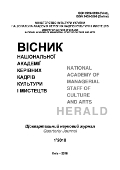IDENTIFYING MANAGERS’ MENTAL MODELS OF EXPORT DEVELOPMENT STIMULI IN THE MARKET OF DEVELOPING COUNTRIES
DOI:
https://doi.org/10.32461/2226-3209.1.2018.178777Анотація
Abstract. Managers form their mental models of a competitive environment, and differences in mental
models lead to different managerial decisions and performance levels for the firm. Despite the repeated requests of researchers in the literature, little is known about market actors’ mental models. On the other hand, considering the role of export in the economic growth and development of countries, researchers have begun to analyze emerging аnd developing markets in recent years. Thus, the present study aims to identify the mental model of export stimuli belonging to managers of Iranian firms active in the dairy industry. The contribution of this study is entering the theory of mental models into international marketing studies and explaining perceptual differences based on this theory. To this end, interviews with experts continued until saturation point using theoretical sampling. Based on the data resulting from semi-structured interviews analyzed using thematic analysis in MAXQDA, six mental models were identified among chief managers of 12 dairy firms: these models include government-based, benefit-based, firm-based, brand-based, manager-based, and environment-based. Results showed that government-, benefit-, and brand-based mental models are the most prominent models in this study, respectively. Moreover, the points raised in the government-based mental model refer to potential export stimuli, while the points raised in other mental models point to actual export stimuli.
Keywords: Mental model, Export stimuli, Export performance, Developing countries
Посилання
Aharoni, Y., Tihanyi, L., & Connelly, B.L. (2011). Managerial decision-making in international business: A
forty-five-year retrospective. Journal of World Business, 46, 135–142.
Axinn, C.N. (1988). Export performance: do managerial perceptions make a difference?. International
Marketing Review, 5 (2), 61 – 71.
Baldauf, A., Cravens, D.W., & Wagner, U. (2000). Examining determinants of export performance in small
open economies. Journal of World Business, 35 (1), 61–79.
Boubakri, W.F., Zghidi, A.B.Y., & Zaiem, I. (2013). The Effect of Export Stimuli on Export Performance:
The Case of the Tunisian Industrial Firms. International Review of Management and Business Research, 2(1), 155-167.
Brooks, M. R., & Rosson, P.J. (1982). A study of export behavior of small and medium-sized
manufacturing firms in three Canadian provinces, in Czinkota, M. R. and Tesar, G., (Eds.), Export Management: An
International Context, Praeger Publishers, New York, 39-54.
Cahen, F.R., Lahiri, S., & Borini, F.M. (2015). Managerial perceptions of barriers to internationalization:
An examination of Brazil's new technology-based firms. Journal of Business Research, 69(6), 1973-1979.
Calantone, R.J., Di Benedetto, C.A. & Song, M. (2010). The impact of industry environment on early
market entry decisions by B2B managers in the US and Japan. Industrial Marketing Management, 39(5), 832-43.
Cavusgil, S. T., & Nevin, J. R. (1981). Internal determinants of export marketing behavior: An empirical
investigation. Journal of Marketing Research, 18, 114–119.
Cavusgil, S. T., Bilkey, W. J., & Tesar, G. (1979). A note on the export behavior of firms: Exporter profiles.
Journal of International Business Studies, 10(1), 91–104.
Danaeifard, H., & Emami, S.M. (2007). Strategies of Qualitative Research: A Reflection on Grounded
Theory. Strategic Management Thought, 1(2), 69-97.
Di Benedetto, C.A., & Song, M. (2008). Managerial perceptions of global pioneering advantage:
Theoretical framework and empirical evidence in the U.S. and Korea. Industrial Marketing Management, 37, 863–872.
Dichtl, E., Koeglmayr, H.G, &Mueller, S. (1990). International orientation as a precondition for export success. Journal of International Business Studies, 21(1(, 23–40.
Eshghi, Abdolreza (1992). Attitude–behaviour inconsistency in exporting. International Marketing Review,9(3), 40–61.
Fernandez, Z. Nieto, M.J. (2005). Internationalization Strategy of Small and Medium‐Sized Family Businesses: Some Influential Factors. Family Business Review, 18(1), 77-89.
Gray, M.S., & Wood, R.E. (2011). Mental Models, Decision Rules, and Performance Heterogeneity. Strategic Management Journal, 32 (6), 569-594.
Haghighi, M., Firouzian, M., & Najafi Majd, S. (2008). Identification of the Determining Factors of the
Export Performance in the Food Industries. Iranian Business Management, 1(1), 3-20.
Hutchinson, K., Quinn, B., & Alexander, N. (2006). The role of management characteristics in the internationalisation of SMEs: Evidence from the UK retail sector. Journal of Small Business and Enterprise Development, 13 (4), 513 – 534.
Johanson, J., & Vahlne, J.E. (1977). The internationalization process of the firm — A model of knowledge development and increasing foreign market commitments. Journal of International Business Studies, 8(1), 23–32.
Johanson, W. J., & Czinkota, M. R. (1982). Managerial motivations as determinants industrial export behavior, in Czinkota, M.R. and Tesar, G. (Eds.), Export Management: an International context, Praeger Publishers, New York.
Joynt, P. (1982). An empirical study of Norwegian export behaviour . dans M.R. Czinkota et G. Tesar (dir.),
Export Management: An International Context, Praeger, New York, p. 55-69.
Kahiya, E.T., & Dean, D.L. (2014). Export performance: multiple predictors and multiple measures
approach. Asia Pacific Journal of Marketing and Logistics, 26 (3), 378 – 407.
Karakaya, F., & Yannopoulos, P. (2010). Defensive strategy framework in global markets. European
Journal of Marketing, 44(7/8), 1077 – 1100.
##submission.downloads##
Номер
Розділ
Ліцензія
Автори, які публікуються у цьому журналі, погоджуються з наступними умовами:
1. Автори залишають за собою право на авторство своєї роботи та передають журналу право першої публікації цієї роботи на умовах ліцензії Creative Commons Attribution License, котра дозволяє іншим особам вільно розповсюджувати опубліковану роботу з обов'язковим посиланням на авторів оригінальної роботи та першу публікацію роботи у цьому журналі.
2. Автори мають право укладати самостійні додаткові угоди щодо неексклюзивного розповсюдження роботи у тому вигляді, в якому вона була опублікована цим журналом (наприклад, розміщувати роботу в електронному сховищі установи або публікувати у складі монографії), за умови збереження посилання на першу публікацію роботи у цьому журналі.
3.Політика журналу дозволяє і заохочує розміщення авторами в мережі Інтернет (наприклад, у сховищах установ або на особистих веб-сайтах) рукопису роботи, як до подання цього рукопису до редакції, так і під час його редакційного опрацювання, оскільки це сприяє виникненню продуктивної наукової дискусії та позитивно позначається на оперативності та динаміці цитування опублікованої роботи.

